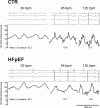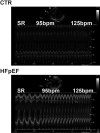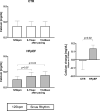Heart Rate-Induced Myocardial Ca2+ Retention and Left Ventricular Volume Loss in Patients With Heart Failure With Preserved Ejection Fraction
- PMID: 32856526
- PMCID: PMC7660766
- DOI: 10.1161/JAHA.120.017215
Heart Rate-Induced Myocardial Ca2+ Retention and Left Ventricular Volume Loss in Patients With Heart Failure With Preserved Ejection Fraction
Abstract
Background Increases in heart rate are thought to result in incomplete left ventricular (LV) relaxation and elevated filling pressures in patients with heart failure with preserved ejection fraction (HFpEF). Experimental studies in isolated human myocardium have suggested that incomplete relaxation is a result of cellular Ca2+ overload caused by increased myocardial Na+ levels. We tested these heart rate paradigms in patients with HFpEF and referent controls without hypertension. Methods and Results In 22 fully sedated and instrumented patients (12 controls and 10 patients with HFpEF) in sinus rhythm with a preserved ejection fraction (≥50%) we assessed left-sided filling pressures and volumes in sinus rhythm and with atrial pacing (95 beats per minute and 125 beats per minute) before atrial fibrillation ablation. Coronary sinus blood samples and flow measurements were also obtained. Seven women and 15 men were studied (aged 59±10 years, ejection fraction 61%±4%). Patients with HFpEF had a history of hypertension, dyspnea on exertion, concentric LV remodeling and a dilated left atrium, whereas controls did not. Pacing at 125 beats per minute lowered the mean LV end-diastolic pressure in both groups (controls -4.3±4.1 mm Hg versus patients with HFpEF -8.5±6.0 mm Hg, P=0.08). Pacing also reduced LV end-diastolic volumes. The volume loss was about twice as much in the HFpEF group (controls -15%±14% versus patients with HFpEF -32%±11%, P=0.009). Coronary venous [Ca2+] increased after pacing at 125 beats per minute in patients with HFpEF but not in controls. [Na+] did not change. Conclusions Higher resting heart rates are associated with lower filling pressures in patients with and without HFpEF. Incomplete relaxation and LV filling at high heart rates lead to a reduction in LV volumes that is more pronounced in patients with HFpEF and may be associated with myocardial Ca2+ retention.
Keywords: Ca2+ cycling/excitation-contraction coupling; heart failure; hypertension; ion channels/membrane transport; mechanisms.
Conflict of interest statement
UVM and Dr Meyer have licensed patents for the use of pacemakers for the prevention and treatment of HFpEF. The remaining authors have no disclosures to report.
Figures






References
-
- Messerli FH, Rimoldi SF, Bangalore S. The transition from hypertension to heart failure: contemporary update. JACC Heart failure. 2017;5:543–551. - PubMed
-
- Topol EJ, Traill TA, Fortuin NJ. Hypertensive hypertrophic cardiomyopathy of the elderly. New Engl J Med. 1985;312:277–283. - PubMed
-
- Hay I, Rich J, Ferber P, Burkhoff D, Maurer MS. Role of impaired myocardial relaxation in the production of elevated left ventricular filling pressure. Am J Physiol Heart Circ Physiol. 2005;288:H1203–H1208. - PubMed
-
- Solomon SD, Rizkala AR, Lefkowitz MP, Shi VC, Gong J, Anavekar N, Anker SD, Arango JL, Arenas JL, Atar D, et al. Baseline characteristics of patients with heart failure and preserved ejection fraction in the PARAGON-HF Trial. Circ Heart Fail. 2018;11:e004962. - PubMed
Publication types
MeSH terms
Substances
Grants and funding
LinkOut - more resources
Full Text Sources
Medical
Miscellaneous

